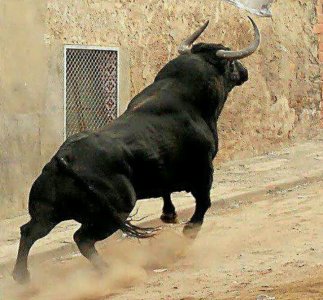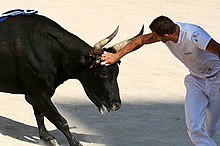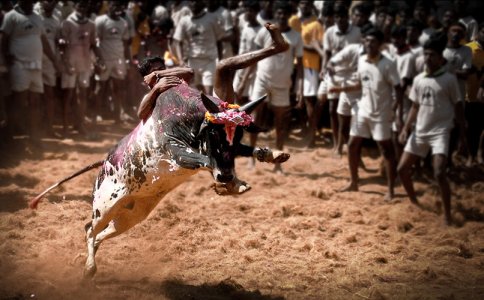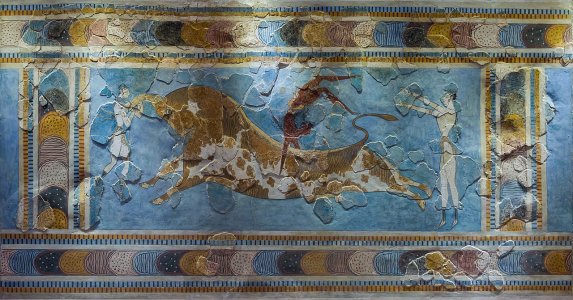When the bull wins they kill him anyway.
I realize why they torture the bull with spikes, so he can't hook and toss his tormentors.

In some countries there are bullfights where the bull is not killed.
Course camarguaise (
course libre) in France
A raseteur takes a rosette

A genre of bullfighting is widely common in the
Provence and
Languedoc areas, and is known alternately as "
course libre" or "
course camarguaise". This is a bloodless spectacle (for the bulls) in which the objective is to snatch a rosette from the head of a young bull. The participants, or
raseteurs, begin training in their early teens against young bulls from the
Camargue region Before the
course, an
abrivado—a "running" of the bulls in the streets—takes place, in which young men compete to outrun the charging bulls. The
course itself takes place in a small arena erected in a town square. For a period of about 15–20 minutes, the
raseteurs compete to snatch rosettes (
cocarde) tied between the bulls' horns. Afterward, the bulls are herded back to their pen by
gardians (Camarguais
cowboys) in a
bandido, amidst a great deal of ceremony. The stars of these spectacles are the bulls.
[18]
At one point, it resulted in so many fatalities that the French government tried to ban it but had to back down in the face of local opposition. The bulls themselves are generally fairly small, much less imposing than the adult bulls employed in the
corrida. Nonetheless, the bulls remain dangerous due to their mobility and vertically formed horns. Participants and spectators share the risk; it is not unknown for angry bulls to smash their way through barriers and charge the surrounding crowd of spectators. The
course landaise is not seen as a dangerous sport by many, but écarteur Jean-Pierre Rachou died in 2003 when a bull's horn tore his
femoral artery.
Course landaise
Another type of French 'bullfighting' is the "
course landaise", in which cows are used instead of bulls. The cows are brought to the arena then taken out in order. The teneur de corde controls the dangling rope attached to the cow's horns and the entraîneur positions the cow to face and attack the player. The écarteurs will try, at the last possible moment, to dodge around the cow and the sauteur will leap over it.
Jallikattu is a traditional spectacle in
Tamil Nadu,
India. A Brahma bull is released into a group of people, and participants attempt to grab the bull's hump and hold onto it for a determined distance, length of time, or with the goal of taking a pack of money tied to the bull's horns.

A youth trying to take control of a bull at a
Jallikattu in
Tamil Nadu,
India

In California, velcro tipped lances are aimed at velcro pads. Women also participate
- In Bolivia, bulls are not killed nor injured with any sticks. The goal of Bolivian toreros is to provoke the bull with taunts without getting harmed themselves.[19]
- In El Seibo Province of the Dominican Republic bullfights are not about killing or harming the animal, but taunting and evading it until it is tired.

- In Canada, Portuguese-style bullfighting was introduced in 1989 by Portuguese immigrants. the practice was allowed as the bulls were not killed or injured in this version
- Jallikattu is a traditional spectacle in Tamil Nadu, India. A Brahma bull is released into a group of people, and participants attempt to grab the bull's hump and hold onto it for a determined distance, length of time, or with the goal of taking a pack of money tied to the bull's horns.
- American Freestyle Bullfighting is a style of bullfighting developed in American rodeo. The style was developed by the rodeo clowns
- In California's Central Valley, the historically Portuguese community has developed a form of bullfight in which the bull is taunted by a matador, but the lances are tipped with velcrow and they are aimed at pads secured to the bull's shoulder.
- In Tanzania, the bull is restrained by a rope, generally neither bull nor player is harmed, and the bull is not killed at the end of the fight.[29][30]
- In Zhejiang, China, guanniu is a traditional form of bullfighting in which contestants attempt to physically wrestle a bull to the ground.[31]





